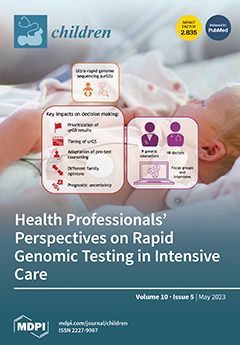Background: Appendectomy is still the standard treatment for acute appendicitis in the majority of centers. Despite all available diagnostic tools, the rates of negative appendectomies are still relatively high. This study aimed to determine negative appendectomy rates and to analyze the demographic and
[...] Read more.
Background: Appendectomy is still the standard treatment for acute appendicitis in the majority of centers. Despite all available diagnostic tools, the rates of negative appendectomies are still relatively high. This study aimed to determine negative appendectomy rates and to analyze the demographic and clinical data of the patients whose histopathology report was negative. Methods: All patients younger than 18 years who underwent appendectomy for suspected acute appendicitis in the period from 1 January 2012 to 31 December 2021 were included in the single-center retrospective study. Electronic records and archives of histopathology reports were reviewed for patients with negative appendectomy. The primary outcome of this study was a negative appendectomy rate. Secondary outcomes comprehended the rate of appendectomies and the association of age, sex, body mass index (BMI), values of laboratory markers, scoring systems, and ultrasound reports with negative histopathology reports. Results: During the study period, a total of 1646 appendectomies for suspected acute appendicitis were performed. In 244 patients, negative appendectomy was reported regarding the patients’ pathohistology. In 39 of 244 patients, other pathologies were found, of which ovarian pathology (torsion and cysts) torsion of greater omentum and Meckel’s diverticulitis were the most frequent. Finally, the ten-year negative appendectomy rate was 12.4% (205/1646). The median age was 12 years (interquartile range, IQR 9, 15). A slight female predominance was noted (52.5%). A significantly higher incidence of negative appendectomies was noted in girls, with a peak incidence between the ages of 10 and 15 years (
p < 0.0001). Male children whose appendectomy was negative had significantly higher BMI values compared to female patients (
p = 0.0004). The median values of white blood cell count, neutrophil count, and CRP in the patients with negative appendectomy were 10.4 × 10
9/L, 75.9%, and 11 mg/dL, respectively. The median of Alvarado’s score was 6 (IQR 4; 7.5), while the median of the AIR score was 5 (IQR 4, 7). The rate of children with negative appendectomy who underwent ultrasound was 34.4% (84/244), among which 47 (55.95%) concluded negative reports. The rates of negative appendectomies were not homogenous in terms of distribution regarding the season. The incidence of negative appendectomies was more frequent during the cold period of the year (55.3% vs. 44.7%;
p = 0.042). Conclusions: The majority of negative appendectomies were performed in children older than 9 years and most frequently in female children aged 10 to 15 years. In addition, female children have significantly lower BMI values compared to male children with negative appendectomy. An increase in the utilization of auxiliary diagnostic methods such as computed tomography could affect the reduction in the pediatric negative appendectomy rate.
Full article






